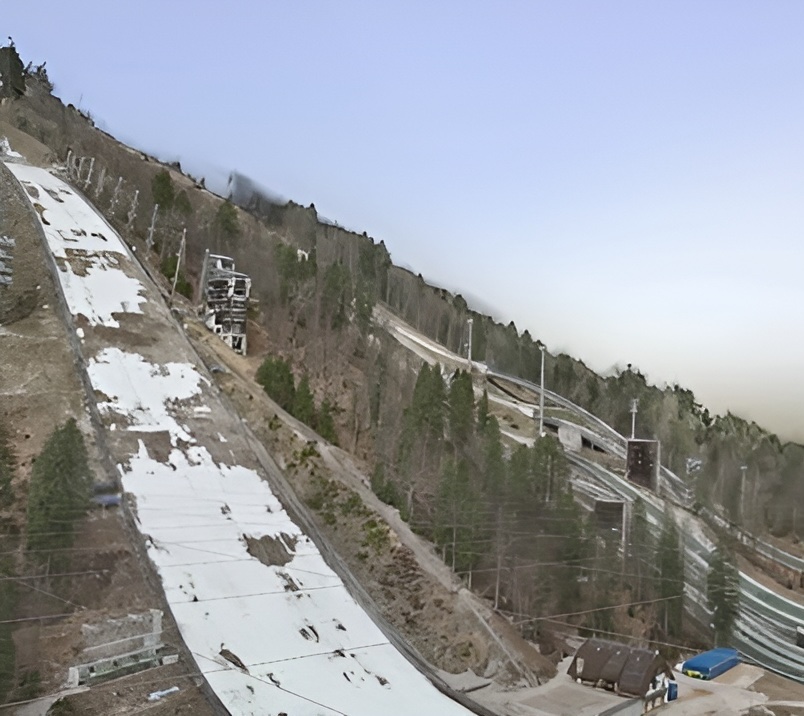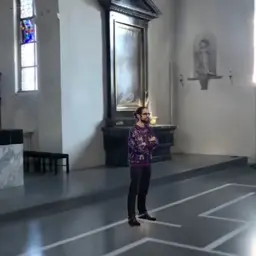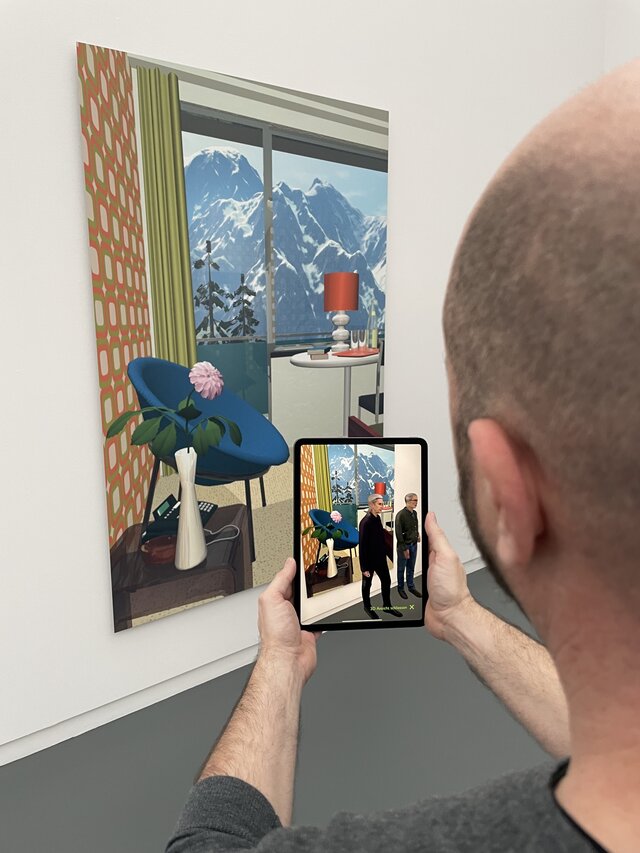publications
Published research papers, articles, and other works.
2025
- IMX 2025
 VR Planica: Gaussian Splatting Workflows for Immersive StorytellingPhilipp Haslbauer, Mike Pullen, Matej Praprotnik, and 5 more authorsIn Proceedings of the ACM International Conference on Interactive Media Experiences Workshops, Niterói/RJ, 2025
VR Planica: Gaussian Splatting Workflows for Immersive StorytellingPhilipp Haslbauer, Mike Pullen, Matej Praprotnik, and 5 more authorsIn Proceedings of the ACM International Conference on Interactive Media Experiences Workshops, Niterói/RJ, 2025Gaussian Splatting recently gained a lot of interest for 3D digitization of real-world objects and scenes. Easy-to-use tools are available to professionals, academics, and lay users for 3D asset creation and visualization. However, application in productions such as XR experiences and corresponding workflows have not been studied in detail so far. We present VR Planica, a pioneering experience that applies Gaussian Splatting for immersive storytelling in a journalistic context, where users are immersed into a real environment. We evaluate available tools and present our production workflow. Finally, results of an initial user study are presented.
@inproceedings{haslbauer2025vrplanica, author = {Haslbauer, Philipp and Pullen, Mike and Praprotnik, Matej and Stimec, Sabrina and Hospital, Marie and Grosbois, Alexandre and Reichherzer, Carolin and Smolic, Aljosa}, title = { VR Planica: Gaussian Splatting Workflows for Immersive Storytelling}, booktitle = {Proceedings of the ACM International Conference on Interactive Media Experiences Workshops}, location = {Niterói/RJ}, year = {2025}, keywords = {}, issn = {0000-0000}, pages = {47--53}, publisher = {SBC}, address = {Porto Alegre, RS, Brasil}, doi = {10.5753/imxw.2025.8141}, url = {https://sol.sbc.org.br/index.php/imxw/article/view/35226}, } - SMPTE 2025VVGLTF: Efficient Streaming of Volumetric Video with GLTFKit Yung Lam, Simone Croci, Philipp Haslbauer, and 1 more authorSMPTE Motion Imaging Journal, 2025
Volumetric Video (VV) allows audiences to experience real-world scenery in full 6° of freedom, i.e., selecting individual viewpoints and directions. It is often produced as point clouds or meshes with shape and texture data. This leads to a substantial volume of data that requires efficient compression. However, there is a lack of universally accepted standards for VV, resulting in many organizations implementing their own approaches. Hence, we suggest Volumetric Video Graphics Library Transmittal Format (VVglTF), an extension of the open-source 3D content format glTF, which is optimized for the Internet. We utilize glTF’s rendering workflow to play VV of any duration or file size efficiently. Custom extensions in glTF expand the functionality of the basic model and offer customization for VV playback. We also developed a simple and efficient VVglTF streaming system based on HTTP. It is designed to play VV content across different network conditions efficiently. In our experiments, we validated the efficiency of our approach.
@article{lam2025vvgltf, title = {VVGLTF: Efficient Streaming of Volumetric Video with GLTF}, author = {Lam, Kit Yung and Croci, Simone and Haslbauer, Philipp and Smolic, Aljosa}, journal = {SMPTE Motion Imaging Journal}, volume = {134}, number = {1}, pages = {57--63}, year = {2025}, } - Preprint
 Gaussian Splatting vs. Classical Photogrammetry: A Comparison for Virtual BackdropsPhilipp Haslbauer, Mike Pullen, Carolin Reichherzer, and 1 more author. More Information can be found here. , Jul 2025
Gaussian Splatting vs. Classical Photogrammetry: A Comparison for Virtual BackdropsPhilipp Haslbauer, Mike Pullen, Carolin Reichherzer, and 1 more author. More Information can be found here. , Jul 2025This paper describes and evaluates three end-to-end workflows from capture to reconstruction including photogrammetry, 3D Gaussian splatting (GS), and extraction of textured meshes from splats with the explicit aim of individuals unfamiliar with 3D reconstruction creating backdrops for virtual production with a central presenter by using a smartphone as capture device. We show that GS significantly outperforms the alternatives in our experiments.
2024
- OtherAffordable Workflows for Volumetric Video Applications in XR to Enhance Museum ExperiencesANH NGUYEN, ARIANA HUWILER, PHILIPP HASLBAUER, and 5 more authorsJul 2024
Volumetric video (VV) is an emerging 3D format that allows the integration of real people into XR (extended reality) applications, enhancing immersive experiences across various fields. Traditionally, VV content creation requires complex and costly multi-camera setups in specialized studios, limiting accessibility for lower-budget productions. Recent AI-based methods have enabled VV capture using simpler, more affordable setups, such as single handheld cameras or mobile phones, making this technology accessible for a wider variety of applications and on-location captures. However, these methods often compromise visual fidelity compared to professional studio productions. This study addresses the quality, acceptance, and integration of VV content creation in an augmented reality (AR) application designed to enhance museum experiences. Here, we demonstrate that users find significant added value and engagement when interacting with VV representations of artists within the AR app despite the need for improved visual quality of the VV content. The main result reveals that, although the current VV quality is lower than professional standards, users still appreciate and enjoy its immersive experience, indicating a positive reception and potential for further development. This finding contrasts with the previous notion that high visual fidelity is paramount for user acceptance, highlighting the importance of content relevance and interactivity.
- VRST 2024
 A Volumetric Video Application to Enhance Museum ExperiencesAnh Nguyen, Jan Lässig, Anna F Kälin, and 5 more authorsIn Proceedings of the 30th ACM Symposium on Virtual Reality Software and Technology, Jul 2024
A Volumetric Video Application to Enhance Museum ExperiencesAnh Nguyen, Jan Lässig, Anna F Kälin, and 5 more authorsIn Proceedings of the 30th ACM Symposium on Virtual Reality Software and Technology, Jul 2024Volumetric video (VV) is an emerging 3D format that allows theintegration of real people into XR (extended reality) applications.Recent cost-effective AI-based methods have enabled VV captureusing single handheld cameras or mobile phones. This study ad-dresses the quality, integration, and acceptance of AI-based VVcontent creation in an augmented reality (AR) application designedto enhance museum experiences. The main result reveals that, al-though the current VV quality is lower than professional standards,users still find significant added value and enjoy its immersiveexperience.
@inproceedings{nguyen2024volumetric, title = {A Volumetric Video Application to Enhance Museum Experiences}, author = {Nguyen, Anh and L{\"a}ssig, Jan and K{\"a}lin, Anna F and Huwiler, Ariana and Haslbauer, Philipp and Young, Gareth W and Yung, Lam Kit and Smolic, Aljosa}, booktitle = {Proceedings of the 30th ACM Symposium on Virtual Reality Software and Technology}, pages = {1--3}, doi = {https://doi.org/10.1145/3641825.368969}, year = {2024}, } - IBC 2024Vvgltf: Efficient streaming of volumetric video with gltfLam Kit Yung, Simone Croci, Philipp Haslbauer, and 1 more authorIn IBC 2024 Conference Proceedings, Jul 2024
Volumetric Video (VV) lets viewers interact with realistic virtual 3D scenes in real-time. It enhances the quality and realism of video broadcasting and conferencing, delivering a vivid and immersive 3D experience. Holographic communication, concert and VR experiences benefit from it. VV data is often recorded as point clouds or meshes with shape and texture data. This leads to a substantial volume of data that requires efficient compression and streaming. Nevertheless, there is a lack of a universally accepted standards for VV file formats, resulting in many organizations implementing their own individualized approaches. Hence, we suggest VVglTF, a specific extension that supports the glTF file format and ensures VV compatibility. The open-source 3D content file format glTF is optimized for the Internet. We utilize glTF’s rendering workflow to play VV of any duration or file size efficiently. Custom extensions in glTF expand the functionality of the glTF model format and offer customization of VV playback. We also developed a simple and efficient VVglTF streaming system based on HTTP Live Streaming technology for video texturing. It is designed to efficiently play VV content across different network conditions by adjusting the frame rate and number of frames per glTF file. In our experiments we validate the efficiency of our approach.
@inproceedings{yung2024vvgltf, title = {Vvgltf: Efficient streaming of volumetric video with gltf}, author = {Yung, Lam Kit and Croci, Simone and Haslbauer, Philipp and Smolic, Aljosa}, booktitle = {IBC 2024 Conference Proceedings}, year = {2024}, }